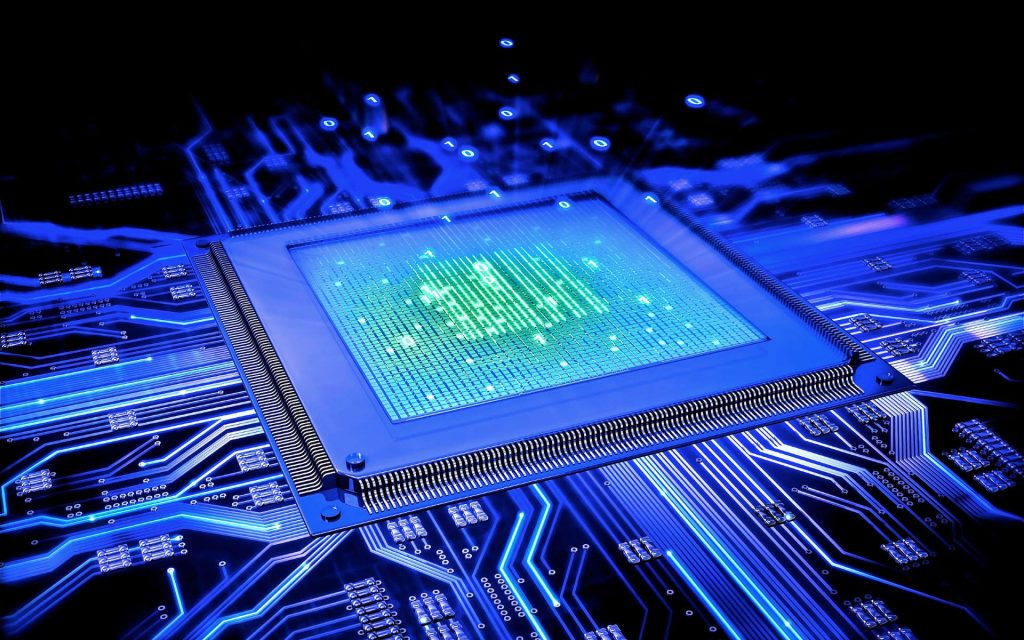… [Trackback]
[…] Find More Information here to that Topic: blog.neterra.cloud/en/shrinking-die-size-of-cpus-what-do-7nm-10nm-and-14nm-mean/ […]

The current generation of CPUs is incredibly small. We are talking about 10nm (nm – nanometer) and even 7nm technology on them! For your reference, a human hair is just 0.06 mm thick or in nanometers – 60 000! And we have already seen attempts to create 5nm technology. Are there any limits ahead?! Why is there such a strong obsession with shrinking the size?
When we talk about processors, the nm size refers to the size of the transistors, not to the actual die size. The goal is to shrink the transistors and put as many as you can in a similar space. You can put multiple cores in the same-sized die and have better results.
Smaller transistors will require less power to function, they will produce less heat when working and have better performance compared to the same size die, with fewer and bigger transistors.
Sounds great, but it is hard as hell to make them so small. Just ask Intel. They had the tick-tock model which had one generation to shrink and the second to keep the size and optimize. It started working in 2007 overall pretty well, with occasional repeats of tocks. In 2014 they got to 14nm and stuck to this decision until 2019! They have finally started moving to 10nm when competitors like AMD and mobile chips are on 7nm and planning to shrink to 5nm.
One small note – 7nm processors will have twice the density of 14nm processors, but it doesn’t mean directly that they will be twice as good. When a company makes a chip, it balances price, performance and power usage.
So, back to the shrinking, the die shrinkage is the process of making transistors smaller. The popular process is called a lithographic node which creates a smaller version of the die. There are many versions – extreme ultraviolet lithography, X-ray lithography, electron beam lithography, nanoimprint and more. One benefit of scaling down is the reduction in material costs. Smaller parts, less raw material.
According to Moore’s law and based on what has happened in the last 50 years, the die size gets roughly twice smaller every 2 years. Moore predicted it just for the period from 1965 to 1975, but the trend has lasted for far longer. Now, most of the specialists in the industry think that the law will soon become obsolete. It is impossible to shrink the size forever. We will soon reach the DNA size (around 2.5nm). So what is next? Who knows, maybe Quantum Computers or something completely new.
… [Trackback]
[…] Find More Information here to that Topic: blog.neterra.cloud/en/shrinking-die-size-of-cpus-what-do-7nm-10nm-and-14nm-mean/ […]
… [Trackback]
[…] Info on that Topic: blog.neterra.cloud/en/shrinking-die-size-of-cpus-what-do-7nm-10nm-and-14nm-mean/ […]
… [Trackback]
[…] There you will find 17329 more Information on that Topic: blog.neterra.cloud/en/shrinking-die-size-of-cpus-what-do-7nm-10nm-and-14nm-mean/ […]
… [Trackback]
[…] Here you will find 16258 more Information to that Topic: blog.neterra.cloud/en/shrinking-die-size-of-cpus-what-do-7nm-10nm-and-14nm-mean/ […]
… [Trackback]
[…] Find More here on that Topic: blog.neterra.cloud/en/shrinking-die-size-of-cpus-what-do-7nm-10nm-and-14nm-mean/ […]
… [Trackback]
[…] Information on that Topic: blog.neterra.cloud/en/shrinking-die-size-of-cpus-what-do-7nm-10nm-and-14nm-mean/ […]
… [Trackback]
[…] Read More here on that Topic: blog.neterra.cloud/en/shrinking-die-size-of-cpus-what-do-7nm-10nm-and-14nm-mean/ […]
… [Trackback]
[…] Find More on on that Topic: blog.neterra.cloud/en/shrinking-die-size-of-cpus-what-do-7nm-10nm-and-14nm-mean/ […]
… [Trackback]
[…] Read More here to that Topic: blog.neterra.cloud/en/shrinking-die-size-of-cpus-what-do-7nm-10nm-and-14nm-mean/ […]
… [Trackback]
[…] Here you can find 26856 more Info to that Topic: blog.neterra.cloud/en/shrinking-die-size-of-cpus-what-do-7nm-10nm-and-14nm-mean/ […]
… [Trackback]
[…] Read More Info here to that Topic: blog.neterra.cloud/en/shrinking-die-size-of-cpus-what-do-7nm-10nm-and-14nm-mean/ […]
… [Trackback]
[…] Read More Information here to that Topic: blog.neterra.cloud/en/shrinking-die-size-of-cpus-what-do-7nm-10nm-and-14nm-mean/ […]
… [Trackback]
[…] Find More Info here on that Topic: blog.neterra.cloud/en/shrinking-die-size-of-cpus-what-do-7nm-10nm-and-14nm-mean/ […]
… [Trackback]
[…] Here you can find 95365 additional Information to that Topic: blog.neterra.cloud/en/shrinking-die-size-of-cpus-what-do-7nm-10nm-and-14nm-mean/ […]
… [Trackback]
[…] Read More to that Topic: blog.neterra.cloud/en/shrinking-die-size-of-cpus-what-do-7nm-10nm-and-14nm-mean/ […]
… [Trackback]
[…] Info on that Topic: blog.neterra.cloud/en/shrinking-die-size-of-cpus-what-do-7nm-10nm-and-14nm-mean/ […]
… [Trackback]
[…] Find More to that Topic: blog.neterra.cloud/en/shrinking-die-size-of-cpus-what-do-7nm-10nm-and-14nm-mean/ […]
… [Trackback]
[…] Find More Information here to that Topic: blog.neterra.cloud/en/shrinking-die-size-of-cpus-what-do-7nm-10nm-and-14nm-mean/ […]
… [Trackback]
[…] Here you will find 40809 more Info to that Topic: blog.neterra.cloud/en/shrinking-die-size-of-cpus-what-do-7nm-10nm-and-14nm-mean/ […]
… [Trackback]
[…] Here you can find 90519 additional Information to that Topic: blog.neterra.cloud/en/shrinking-die-size-of-cpus-what-do-7nm-10nm-and-14nm-mean/ […]
… [Trackback]
[…] Info to that Topic: blog.neterra.cloud/en/shrinking-die-size-of-cpus-what-do-7nm-10nm-and-14nm-mean/ […]